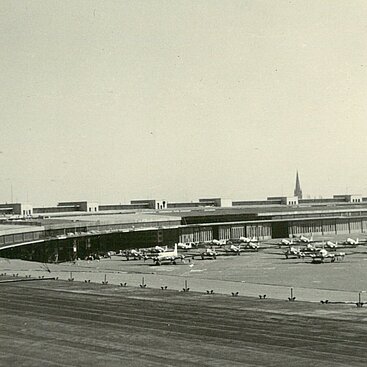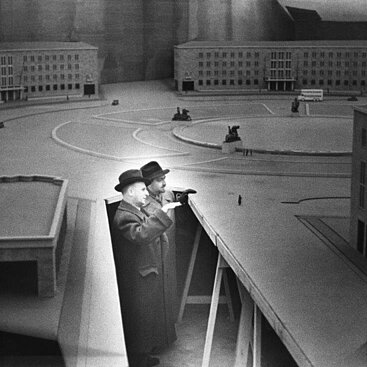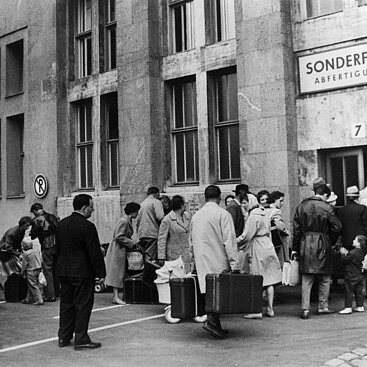Civil aviation
Due to the armament in the First World War, powered flight develops rapidly and also brings about significant advancement for civil aviation. The slow and costly airships could not keep pace. They only served a useful purpose for transatlantic flights till the era of large Zeppelins in 1937 ended in New York with the disaster of LZ 129 »Hindenburg«. Tempelhof continuously took part in this chapter of aviation history from 1923 onwards with the opening of the “Tempelhof field airport”.
A “air-rail” via Berlin
Two years after the demonstration of Schwarz’s all-metal airship, Ferdinand Graf von Zeppelin introduced his own development in 1898. The architect and design engineer is Carl Berg, with whom David Schwarz had already worked. Thanks to the supporting frame inside the cylindrical balloon, the motor gondolas could no longer attach to just the guide gondola as before but to any position of the body. This considerably increased the capability of the rigid airship, which Graf Zeppelin now called LZ “air-rails”.
LZ 1 started on 2nd July 1900 from Lake Constance for its maiden journey. LZ 4 financed by the Prussian Army command is said to have already undertaken a 24-hour ride to Mainz following the requirements of sponsors, reached 1200 m height and landed on solid ground. During this ride, LZ 4 had to stop over due to gas loss and motor failure, caught fire during the obligatory stop and was completely destroyed. The accident triggered a wave of help; more than six million marks were sent by means of which Zeppelin could continue his work. With LZ 6, Graf thanked the German Reich for the generous support. On 29 August 1909, the 136 m long airship powered by two Daimler-Benz motors each with 115 PS appeared in the sky above Berlin on a three-day ride. At a height of just 100 m, the airship moved for half an hour over the Tempelhof field, in which Kaiser Wilhelm II and around 300,000 Berliners were present.
LZ 6 achieved a breakthrough. While it was refurbished, extended to 144 m length and flown in 1910 for the International Aviation Exhibition (ILA) in Frankfurt/Main, military orders were already announced. Even the start of passenger transport with “Zeppelins” is scheduled. “Air-rail” 11 of 1912 is 148 m long and travels 80 km per hour. It was used as recce aircraft and even as a bomber in the First World War and also as passenger aircrafts by the first airline company of the world: “Deutschen Luftschiffahrts Aktiengesellschaft” with headquarters in Frankfurt am Main.
“Dynamic flying machines” disturbed the Kaiser.
Unlike the Swiss painter Arnold Böcklin, who introduced his glider on the Tempelhof field in 1883, Otto Lilienthal, mechanical engineer, maker and “father of flight” never worked on the Tempelhof Areal. The flat surface was not suitable for his purpose because he had to start from a rise for his “personal aerobatics”. After Otto Lilienthals’s plane death in 1896, on the contrary, his brother Gustav unsuccessfully tried there with flapping wing apparatus for more than 20 years depending on the type of birds in the forward flight.
In the meanwhile, the success of the evaluation of Otto Lilienthal’s carefully documented groundwork and his systematically carried out flight attempts is borne by others. In the beginning of the 20th century, the Wright brothers in Dayton (Ohio, USA) succeeded with motorised “box kites”, by means of which they finally abandoned orientation towards the flight of birds and pursued a new direction.
Only five days after the Berlin visit of Grafen Zeppelin in LZ 6, 150,000 spectators experienced another aviation sensation on the Tempelhof field: Orville Wright started his “Aeroplane” and made eight rounds above the military ground with 50 to 60 kilometre per hour. The chief of the Großen Generalstab, Graf von Moltke, was impressed; on the contrary, the Kaiser could not decide whether to personally attend one of Wright’s flight demonstrations in Berlin. The question as to whether the future includes dirigible balloons or aircrafts is still open to debate in the German Reich - especially the latest developments of “dynamic flying machines” do not come from Germany.
In addition to the Wright brothers, even the French Aviatics, among others, became a talking point internationally because of the crossing of the English Channel. From 23rd to 27th September 1909, Hubert Latham of France advertised for Wertheim department store with his flights over the Tempelhof field and unexpectedly became of the local aviation pioneers. In order to participate in a competition in Johannisthal ten kilometres away and to save assembly and transportation charges for his “Antoinette”, he flew the distance and bestowed upon the Prussian capital the third aviation sensation of the year 1909 with this “cross-country flying”.
A day after the opening of the first German airport in Johannisthal in Treptow, the era of fenced airfields became a thing of the past thanks to Latham’s initiative. Johannisthal was the new attraction for flight-enthusiasts and temporarily challenged the Tempelhof field for its rank since the field was still being used by the military and approved air shows only on a case-by-case basis.
The first scheduled flight throughout the world for democracy
During the First World War, aircrafts were initially used in combat operations. More than one fourth of the German military aircrafts, which were manufactured between 1914 and 1918, come from Johannisthal. Production companies such as Rumpler-Werke GmbH, Dorner Flugzeug GmbH and Fokker Flugzeugwerke were located there, which brought superiority to aerial warfare in Germany thanks to the development of monoplane EI to EIV. At the end of the war, biplanes were normally used by the military and were now also designed for rapid manoeuvres. Equipped with two synchronised machine guns firing forwards, they achieved speeds of up to 200 km per hour and finally lost their status as objects of inventors, amateurs and eccentrics.
Just one year before the end of the war, the newly founded “Deutsche Luft-Reederei GmbH” (DLR) began the preparation of a regular commercial scheduled air service. Two years later, on the occasion of the inauguration of Weimar National Assembly, it provided the first scheduled flight of the world on 5th February 1919 with two outward and return flights between Berlin and Weimar. The refurbished military aircrafts stated and landed in Johannisthal. The accident-free flight operation of DLR machines in the following weeks played a major role in the development of civil aviation. The production of passenger aircrafts established the rapid development of powered flight during the war years. Junkers F13 was introduced as the first all-metal aircraft and first commercial aircraft with dual controls for two pilots but only four seats for passengers, a monoplane and low-wing airplane, which was constructed from 1919 to 1932.
The suggestion to make Tempelhof field a permanent airfield was first put forward in the year 1910. At that time, residential construction still had priority over other uses. And the War Office was also not ready to completely separate from the premises; it sold only an essential part between the current Tempelhof Damm and General-Pape-Straße. The great interest of ambitious airlines in a city airport brought about the change. The city of Berlin purchased the eastern part of the areal and thanks to the resourceful and tireless commitment shown by Leonhard Adler, head of the municipal planning and building control office of Berlin, for public transport, flight operation began on 8 October 1923 on the temporarily prepared “Tempelhof field airport”.
St. Endlich, M. Geyler-von Bernus, B. Rossié
Literature
District Office of Tempelhof, Berlin (editor), Landing on Tempelhof. 75 years of central airport – 50 years of airlift, exhibition catalogue, Berlin without date specification (1998)
Deutsche Lufthansa (editor), German aviation. A historic kaleidoscope, no place of publication 1975
Museum for transport and technology (editor), Hundred years of German aviation. Lilienthal and his heirs, Gütersloh/Munich 1991
Frank Schmitz, Airport Tempelhof. Berlin’s Gateway to the World, Berlin 1997
Werner Schwipps, mega cigars and flying boxes. Images from the early period of aviation in Berlin, series of museum for transport and technology, Berlin 1984





